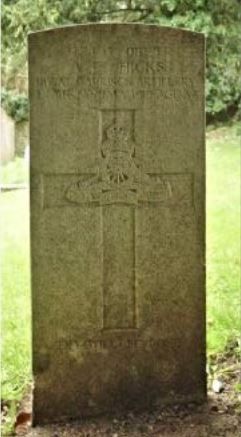3rd Reserve Battery, Royal Garrison Artillery

Curiously, the CWGC ‘Debt of Honour’ Register, generally a reliable source of information, appears to be incorrect with regard to two important details of Driver Hick’s military service, his Army number and his unit.
Albert Edward Hicks was born in 1880 at Didmarton, Gloucestershire. He was the son of Frederick Thomas Hicks (1858-1897), a farm labourer and his wife Elizabeth (née Wickes 1856-1951). The couple had two sons, Albert the elder by thirteen years; his brother Frederick James was born in 1893.
In 1881 the Hicks family lived at Oldbury on the Hill and by 1891 had moved to Clayfields Barn, Shipton Moyne. Frederick died in 1897 and in March 1899 his widow (Albert and Frederick’s mother) married a widower, Robert John Woodward and became step mother to a number of children. At the time of the 1901 Census the family lived at Sopworth St Mary and Albert was employed as a carter on a farm.
In 1906 Albert married Annie Mabel Leach (1880-1960) at Coln St Aldwyns and when the 1911 Census was compiled the couple lived at Moors Farm in the village and Albert’s occupation was as a waggoner on a farm. Certainly up to 1911 there were no children from the marriage and no evidence has been found for any arriving subsequently.
An Army Service Record has survived for Albert. This contains an Attestation Form for military service completed at Cirencester on 9 December 1915. He undertook to serve for the duration of the war and was almost certainly recruited under ‘Lord Derby’s Scheme’, which formed a bridge between voluntary enlistment and compulsory conscription, which came into force in January 1916. He was placed into the Army Reserve, liable to call up at any time. In the meantime, he resumed his civilian occupation. No doubt because he worked on the land, it was almost two and a half years before call up and mobilisation came on 6 May 1918. By this stage of the war the Army was desperately short of men to fill the places of those who had become casualties and various ‘combing out’ operations were conducted to bring in fit men from what had previously been considered ‘protected’ occupations.
When mobilised Albert was posted to the Royal Garrison Artillery (RGA), as driver. As the Army relied upon horse power to pull much of their equipment his experience as a waggoner would be useful. He was given the number 213498 and this is the number which appears in all his military records and is present on his headstone. It is not known how and why the number Z/3498 appears in his entry in the CWGC Register.
After reporting for duty at an RGA Depot in Plymouth, Albert was posted to the 4th Reserve Battery, located at Hazeley Down Camp at Twyford, Hampshire. Very soon after he was admitted to the camp hospital, diagnosed as suffering from influenza. He spent fifty days there (from 16 May to 21 July 1918) and upon discharged was considered to be very debilitated and recommended for light duties only.
Possibly what had appeared to be influenza was in fact something more sinister, as on 11 October he was back in the Hazeley Down Camp’s hospital, identified as suffering from pulmonary tuberculosis. He remained there until 13 December and was then transferred to a hospital which had been established at Magdalen Camp, Winchester. He died there, at 2.45am, on 14 January 1919, aged 38. His next of kin were present. Prior to his death he had been transferred to the 3rd Reserve Battery (probably for administrative reasons, having been struck off the RGA’s active strength). There is no mention, anywhere, of him serving with the ‘106 Reserve Brigade’ shown in the CWGC Register.
Driver Albert Edward Hicks was buried in the churchyard of St John the Baptist, Coln St Aldwyns, where a standard CWGC headstone marks his grave. He is commemorated on the village war memorial.
Researched by Graham Adams 19 September 2020
